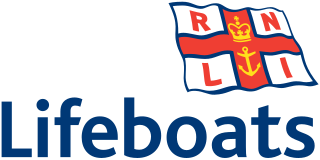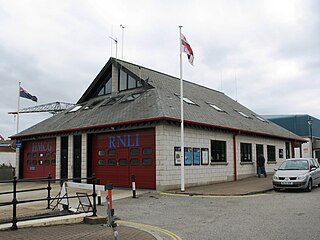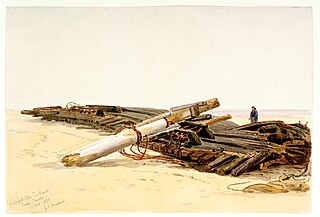
The Royal National Lifeboat Institution (RNLI) is the largest of the lifeboat services operating around the coasts of the United Kingdom, the Republic of Ireland, the Channel Islands, and the Isle of Man, as well as on some inland waterways.

Clovelly is a privately owned harbour village in the Torridge district of Devon, England. The settlement and surrounding land belongs to John Rous who inherited it from his mother in 1983. He belongs to the Hamlyn family who have managed the village since 1738.

The United States Life-Saving Service was a United States government agency that grew out of private and local humanitarian efforts to save the lives of shipwrecked mariners and passengers. It began in 1848 and ultimately merged with the Revenue Cutter Service to form the United States Coast Guard in 1915.

Lifesaving is the act involving rescue, resuscitation and first aid. It often refers to water safety and aquatic rescue; however, it could include ice rescue, flood and river rescue, swimming pool rescue and other emergency medical services. Lifesaving also refers to sport where lifesavers compete based on skills, speed and teamwork. Lifesaving activities specialized in oceanic environment is called surf lifesaving or coastal lifesaving.
Blyth Lifeboat Station is operated by the Royal National Lifeboat Institution and currently operates a D-class (IB1) Sally Forth (D-878) and a B-class lifeboat Patricia Southall (B-923)

Dunbar Lifeboat Station is a lifeboat station located in Dunbar Harbour at Dunbar, on the south-east coast of Scotland, operated by the Royal National Lifeboat Institution. The station operates a Trent-class all-weather lifeboat and a D-class (IB1) inshore lifeboat. Dunbar is one of the earlier British ports to be served by a lifeboat, the first station being constructed in 1808.
A rescue lifeboat is a boat rescue craft which is used to attend a vessel in distress, or its survivors, to rescue crew and passengers. It can be hand pulled, sail powered or powered by an engine. Lifeboats may be rigid, inflatable or rigid-inflatable combination-hulled vessels.

Ramsgate Lifeboat Station is a Royal National Lifeboat Institution (RNLI) station located in the Port of Ramsgate in the English county of Kent. The station is one of the oldest to operate in the British Isles and has launched to many notable services. Among the awards won by its crews over the years are 42 RNLI medals, including 2 gold, 39 silver and 1 bronze, the last being awarded in 2000.

Falmouth Lifeboat Station is the base for Royal National Lifeboat Institution (RNLI) search and rescue operations at Falmouth, Cornwall in the United Kingdom. The first lifeboat was stationed in the town in 1867 and the present station was opened in 1993. It operates a Severn Class all-weather Lifeboat (ALB) and an Atlantic 85 inshore lifeboat (ILB).

Teignmouth Lifeboat Station is the base for Royal National Lifeboat Institution (RNLI) search and rescue operations at Teignmouth, Devon in England. The first lifeboat was stationed in the town in 1851 but the station was closed from 1940 until 1990. Since 2006 it has operated an Atlantic 85 inshore lifeboat (ILB).

Ellen Southard was an American full-rigged merchant ship from Bath, Maine that was built in 1863 by prominent shipbuilder T.J. Southard. She plied international trade routes for twelve years, calling at ports as far away as Sydney.

Newhaven Lifeboat Station is an RNLI station located in the town of Newhaven in the English county of East Sussex in the United Kingdom. The station operates as an all-weather lifeboat station. The original station was established in 1803 and taken over by the RNLI in 1854. The current lifeboat (2014) is the Severn class David and Elizabeth Acland.

Cardigan Lifeboat Station, at Poppit Sands, North Pembrokeshire, near Cardigan, Ceredigion, Wales, is a Royal National Lifeboat Institution (RNLI) lifeboat station opened in 1849. The station closed in 1932 but reopened in 1971 as an inshore lifeboat station.

Hayling Island Lifeboat Station is a Royal National Lifeboat Institution station located on Hayling Island close to the town of Mengham in the English county of Hampshire. The station is located on the eastern side of Hayling island at the entrance to Chichester Harbour where it joins the major shipping route of the Solent, and is opposite the village of West Wittering. This major shipping route is busy at all times of the year and there are estimated to be 10,000 boats in the Chichester area alone. The Hayling Island station provides cover for the area 24 hours a day, all year, by means of two inshore rigid inflatable lifeboats placed on this station.

Happisburgh Lifeboat Station is a Royal National Lifeboat Institution (RNLI) Inshore lifeboat station close to the village of Happisburgh in the English county of Norfolk in the United Kingdom. Since 2003 the station boathouse has been re-located from the village to an area south called Cart Gap. This is because the beach below Happisburgh disappeared due to coastal erosion and the stations slipway and access was washed away. The original boathouse in the village is now used for training.

Eastbourne Lifeboat Station is a Royal National Lifeboat Institution (RNLI) lifeboat station in the town of Eastbourne in East Sussex. Founded two years before the RNLI was established, the station has operated continuously since 1822 and its lifeboats have been responsible for saving over 700 lives. There are two active lifeboat stations in Eastbourne, an all-weather station with the Trent-class 14-02 Esme Anderson at Sovereign Harbour and the D-class (IB1) The David H (D-876) at the inshore lifeboat station a couple of miles to the west at Fisherman's Green. An older lifeboat station, west of Eastbourne Pier, is now used as an RNLI museum.

Clovelly Lifeboat Station, serving the North Devon village of Clovelly and surrounding coastal waters, is run by the Royal National Lifeboat Institution (RNLI). It was established in 1870. The station is flanked by Appledore to the northeast and Bude to the southwest.

Filey Lifeboat Station is a Royal National Lifeboat Institution (RNLI) lifeboat station located in the town of Filey, North Yorkshire, England. It is one of nine operational RNLI lifeboat stations situated on the Yorkshire Coast.
A number of awards have been established by the Royal National Lifeboat Institution (RNLI) since its creation in 1824. None are approved by the Crown, and are therefore unofficial awards. As such, they do not appear in the official British order of wear, although the principal lifesaving award, the Medal of the RNLI, can be worn on the right breast in uniform by members of the British armed forces.

Thurso Lifeboat Station is located at Scrabster Harbour, in the NE corner of Scotland, near the town of Thurso, Highland, in the historic county of Caithness.
A lifeboat was first stationed here by the Royal National Lifeboat Institution in 1860.

















